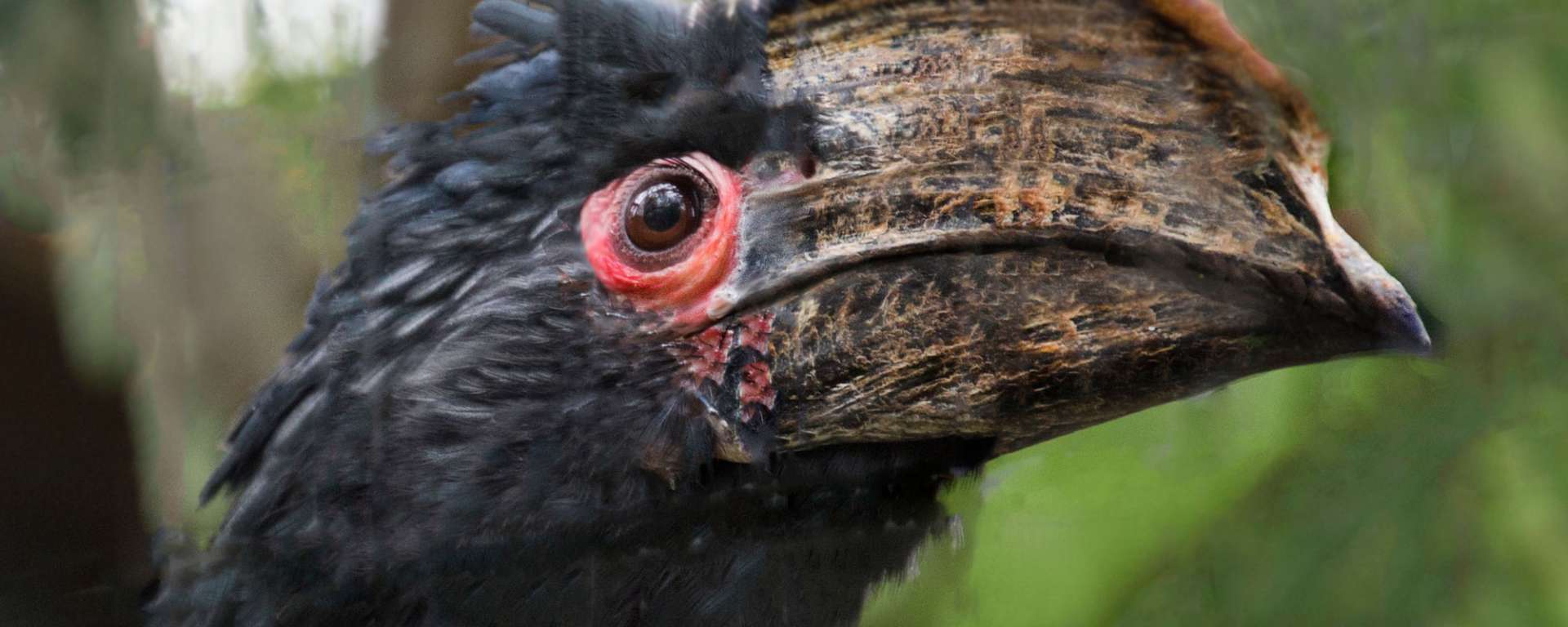Description
The trumpeter hornbill is a medium-sized bird with white and black feathers on the back and belly, and white tips on the wing and tail feathers. The beak is large, black, and has a pronounced casque (enlarged beak) which is larger on the males than the females. The skin around the male’s eyes is red to purple in color. The female’s beak is yellowish at the base. Juveniles have more brownish feathers and no casque. The trumpeter hornbill is about 50-55 cm (20 inches) tall. Males weigh 600-900 g (about 1.5 pounds); females weigh 450-650 g (about 1 pound). The wingspan is 60 cm (about 24 inches).
Classification
- Class
- Aves
- Order
- Bucerotiformes
- Family
- Bucerotidae
- Genus
- Bycanistes
- Species
- B. bucinator
- Conservation Status
- Least Concern
Key Facts
- Height
- 50-55 cm (20 inches)
- Weight
- 450-900 g (1-1.5 pounds)
The IUCN Red List classifies Bycanistes bucinator as a species of Least Concern. While there is no credible data regarding global population size, the species is locally common across a wide range. The population is expected to be in decline due to ongoing habitat loss across the species’ known range.
Social Life
Trumpeter hornbills do not migrate, but will travel some distance for particular fruits. A flock of trumpeters lives in a communal roost, often with up to 200 members. They vocalize loudly and their calls have a nasal quality.
Habitat and Range
Trumpeter hornbills are found in approximately the same area as their larger cousins, the southern ground hornbills. This range encompasses much of South-Eastern Africa and includes northern Angola, southern Zaire and Kenya, northern Namibia and Botswana and eastern Zimbabwe and South Africa. They live in evergreen forests and tall deciduous woodlands.
Diet
Main diet includes 14 different kinds of fruit, including figs, small birds, and insects. They mainly forage among foliage.
Lifespan
About 20 years.
Predators
Large carnivores and large snakes.
Reproduction
They are monogamous and mate for life.
Sexual Maturity: About 3 years
Mating Season: September through January
Incubation: 28 days.
No. of Young: The female lays 2-4 eggs over a period of days, after a pre-nesting period of 10-15 days. The trumpeter hornbill is a cavity nester. The female is sealed into the cavity with regurgitated mud pellets. The male offers the female and chicks regurgitated food. The female molts (sheds) her large tail and flight feathers while in the nest. Chicks fledge at 50 days; the female reemerges with the chicks.
- Information
-
Description
The trumpeter hornbill is a medium-sized bird with white and black feathers on the back and belly, and white tips on the wing and tail feathers. The beak is large, black, and has a pronounced casque (enlarged beak) which is larger on the males than the females. The skin around the male’s eyes is red to purple in color. The female’s beak is yellowish at the base. Juveniles have more brownish feathers and no casque. The trumpeter hornbill is about 50-55 cm (20 inches) tall. Males weigh 600-900 g (about 1.5 pounds); females weigh 450-650 g (about 1 pound). The wingspan is 60 cm (about 24 inches).
Classification
- Class
- Aves
- Order
- Bucerotiformes
- Family
- Bucerotidae
- Genus
- Bycanistes
- Species
- B. bucinator
- Conservation Status
- Least Concern
Key Facts
- Height
- 50-55 cm (20 inches)
- Weight
- 450-900 g (1-1.5 pounds)
- Conservation
The IUCN Red List classifies Bycanistes bucinator as a species of Least Concern. While there is no credible data regarding global population size, the species is locally common across a wide range. The population is expected to be in decline due to ongoing habitat loss across the species’ known range.
- Lifestyle
Social Life
Trumpeter hornbills do not migrate, but will travel some distance for particular fruits. A flock of trumpeters lives in a communal roost, often with up to 200 members. They vocalize loudly and their calls have a nasal quality.Habitat and Range
Trumpeter hornbills are found in approximately the same area as their larger cousins, the southern ground hornbills. This range encompasses much of South-Eastern Africa and includes northern Angola, southern Zaire and Kenya, northern Namibia and Botswana and eastern Zimbabwe and South Africa. They live in evergreen forests and tall deciduous woodlands.Diet
Main diet includes 14 different kinds of fruit, including figs, small birds, and insects. They mainly forage among foliage.Lifespan
About 20 years.Predators
Large carnivores and large snakes.Reproduction
They are monogamous and mate for life.
Sexual Maturity: About 3 years
Mating Season: September through January
Incubation: 28 days.
No. of Young: The female lays 2-4 eggs over a period of days, after a pre-nesting period of 10-15 days. The trumpeter hornbill is a cavity nester. The female is sealed into the cavity with regurgitated mud pellets. The male offers the female and chicks regurgitated food. The female molts (sheds) her large tail and flight feathers while in the nest. Chicks fledge at 50 days; the female reemerges with the chicks.

